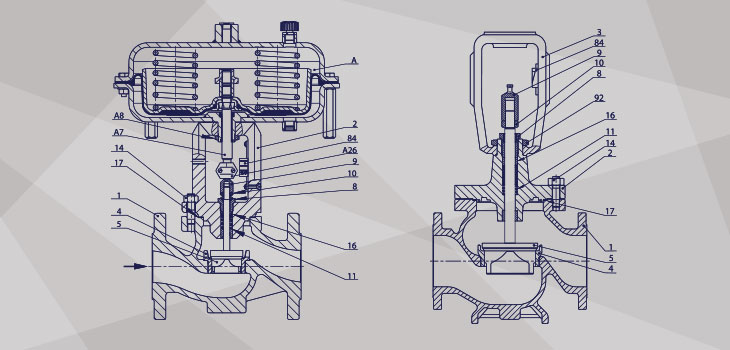Valves come in all sorts of shapes and sizes. This is also true with the parts that make up these valves. These components can be sorted into 4 main categories, with two of them being subcategories.
- Non-Pressure Containing Parts
- Pressure Containing Parts
- Valve Trim
- Resilient or Compressible Parts
This article will cover each of these categories and how they are defined.
Pressure Containing Parts
Pressure containing parts refer to the parts of a valve that contact the line media. Typically, these parts are designed to contain the media inside the valve. Pressure containing parts include the body, bonnet, and control element (gate, plug, disc, etc.). The control element is the part that performs the function of the gate. For example, the control element in a ball valve is the ball.
Body Designs are distinguished by the material that they are made of. There is a range of materials that are used for valve bodies, however they are typically metallic alloys.
Common categories of materials used for valve bodies include:
- Bronze
- Cast & Ductile Iron
- Carbon Steel
- Low Alloy Steel (also known as Chrome Steel)
- Stainless Steels
- Exotic Alloys
Valve body materials are rated according to ASME B16.34, which specifies dimensional standards as well as pressure and temperature ratings.
Bonnets are the cover on the valve body. During manufacturing, the internal parts of a valve are put into the body, and then the bonnet is attached to hold everything together inside. Bonnets have different designs – threaded bonnet, bolted bonnet, pressure seal bonnet and a welded bonnet. Also, note that some valve designs have integral bonnets.
Non-Pressure Containing Parts
Non-Pressure containing parts refer to the parts of a valve that do not encounter with the line media. These components are most often related to the movement of the control element. Depending on the design, non-pressure containing parts could be (but are not limited to) the valve trim – seats, closure element, handwheel, yoke, stem nut, actuator mounting pads, and some external fasteners.
A quick test to determine if a part is pressure containing is visualizing is if that part was missing. If the missing part would cause the valve to leak to the atmosphere, you have a pressure containing part! Vice versa for non-pressure containing parts.
Valve Trim
Valve trim includes the moving and sealing parts of the valve. Usually, these parts are the closure element, seating, and the stem of the valve. In line with every other subset of components, valve trim parts vary depending on the design. For example, in a conventional elastomer seat butterfly valve, the disc, rubber seat, and the stem are considered the valve trim.
As these parts come into contact with the media and perform the valve function, selecting the correct material for the valve trim is essential. The material needs to be strong and more corrosion resistant to protect these components from any difficult operating conditions.
Valve trim can be separated in to two categories, soft seated and metal seated.
Soft Seated trims offer tight seating closure but have a restricted temperature range and can easily be damaged. Elastomeric and plastic polymers are used to create these components. A common elastomeric polymer used is EPDM (ethylene propylene diene monomer), a synthetic rubber. Teflon (Polytetrafluoroethylene), a plastic polymer, is also commonly used for the soft seated trims.
Metal Seated trims can handle high and low temperatures and have more durability compared to soft seated trims. An issue for metal seated trims is that it is harder to get – the tightest isolation closure. Metal seated trims use bronze, stainless and hard coatings like chrome and tungsten carbides.
Resilient or Compressible Parts (Fugitive Emission Seals)
Resilient or compressible parts are characterized as seals that prevent line media from escaping to the atmosphere as fugitive emissions. These seals typically are gaskets or packing.
Gaskets join stationary components of the valve and are static seals. Gaskets can be found solo or in tandem, often referred to primary and secondary seals. For example, a valve may have primary and secondary body seal for emergencies. In one case, the primary seal is made of Teflon for its ability to maintain a seal under normal operating conditions. The secondary seal is made of graphite for its resilience to fire. So, in this case, the primary seal is for normal operating conditions, while the secondary seal is to secure the valve in case of emergency. Gaskets and seals will vary depending on the valve design.
Packing seals moving components of the valve body and are dynamic seals. There are two primary types of packing designs, compression packing and O-ring packing, as well as diaphragm and bellows seal designs
Compression packing is loaded with a packing follower and packing bolts. Compression packing is the most common cause of valve leakage to the atmosphere. Because of this, compression packing maintenance is a regular requirement.
O-ring packings are held in place by machined grooves in the valve body. Because of the dynamics of O-rings fitted in the machined grooves, O-ring packing is non-adjustable and can not be tightened to eliminate packing leaks.
Conclusion
Valve components can be categorized by whether they are pressure containing or not. Pressure containing parts come in contact with line media, and non-pressure containing parts do not. Furthermore, valve trims and resilient/compressible parts are subcategories of pressure containing parts. As stated, these categories are used to describe similar features in valves. However, the individual parts will vary depending on the design.
